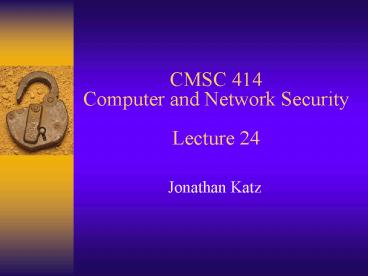CMSC 414 Computer and Network Security Lecture 24 - PowerPoint PPT Presentation
1 / 22
Title:
CMSC 414 Computer and Network Security Lecture 24
Description:
ret. Basic exploit. Suppose stack looks like: When func() exits, user will ... str ret Code for P. Program P: exec( '/bin/sh' ) (exact shell code by Aleph One) ... – PowerPoint PPT presentation
Number of Views:79
Avg rating:3.0/5.0
Title: CMSC 414 Computer and Network Security Lecture 24
1
CMSC 414Computer and Network SecurityLecture 24
- Jonathan Katz
2
Application-level security
3
Application-level security
- I.e., programming-language security
- Previous focus was on protocols and algorithms to
prevent attacks - Are they implemented correctly?
- Here, focus is on programming errors and how to
deal with them - Reducing/eliminating/finding errors
- Containing damage resulting from errors
4
Classifying flaws
- Intentional flaws
- E.g., backdoors
- Unintentional flaws
- E.g., programmer errors
5
Buffer overflows
- 50 of reported vulnerabilities
- Overflowing a buffer results in data written
elsewhere - Users data space/program area
- System data/program code
- Including the stack, or memory heap
- Can also occur in other contexts
- E.g., parameters passed via URL
6
Example
- Suppose a web server contains a function void
func(char str) char buf128 - strcpy(buf, str)
do-something(buf) - When the function is invoked the stack looks
like - What if str is 136 bytes long?
7
Basic exploit
- Suppose stack looks like
- When func() exits, user will be given a
shell !! - Note attack code runs in stack
(exact shell code by Aleph One)
8
Finding buffer overflows
- Hackers find buffer overflows as follows
- Run web server on local machine
- Issue requests with long tags. All long tags end
with - If web server crashes search core dump for
to find overflow location.
9
Incomplete mediation
- E.g., changing symbolic link between checking and
use - E.g., parameters passed via URL
- Parameters may be checked at client-side
- but checking still necessary server-side
- E.g., changing prices in URL
10
Cross-site scripting
- Violation of privacy
- General rule always check inputs from untrusted
source!
11
Time-to-check vs. time-of-use
- Serialization/synchronization flaw
- E.g., presenting command then changing command
while it is being verified
12
Covert channels
- Intentionally inserted by programmers into
software, to later leak information - Examples in booke.g., spacing information in
printed page, formats, etc. - Other examples file lock channel,
existence/non-existence of file, etc.
13
Analysis of covert channels
- Shared resource matrix
- Tabulates subjects and the resources thave have
access to - Information flow analysis (in source code)
- E.g., B A supports info. flow from A to B
- If (D 1) then B A supports info. flow from
D to B also! - Trace information flow throughout program
14
Timing attacks
- Password checking routines
- Web caching
15
Finding/preventing flaws
16
Penetration testing?
- Limited to finding/patching existing flaws
- Cannot be used to guarantee that software is free
of all flaws - Patching flaws in this way has its own problems
- Narrows focus to fixing a specific flaw, rather
than addressing issues more broadly - May introduce new flaws
17
Automated testing
- Successful to some extent
- Hard to catch all flaws
- Traditional program verification/testing focuses
on what a program should do - Here, we are concerned with things a program
should not do
18
Techniques for preventing flaws
- Secure programming
- Developmental controls
- Better techniques
- Secure programming languages
- Static analysis
- Secure compilation
- Dynamic analysis
- Software fault isolation
19
Techniques
- Inferring trust
- Source authentication/code signing
- Proof-carrying code
- OS controls
- Sandboxing
- System-call interposition techniques
- Secure boot of OS
20
Developmental controls
- Modularity
- Improves ability to locate flaws
- Easier to verify/fix code
- Encapsulation/information hiding
- Peer review/testing/analysis
- Automated code testing
21
Secure programming techniques (Based on
Programming Secure Applications for Unix-Like
Systems, David Wheeler)
22
Overview
- Validate all input
- Avoid buffer overflows
- Program internals
- Careful calls to other resources
- Send info back intelligently































